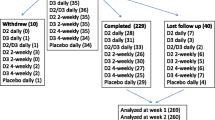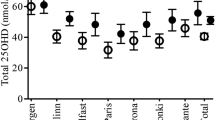Abstract
Summary
To determine how long vitamin D lasts after supplementation ceases, the marker of status was measured 2 and 3 years after a 1-year trial. Compared to placebo, the proportion of vitamin D-deficient women was still lower, if they had taken daily vitamin D3, after 2 years, indicating its longevity.
Introduction
The purpose of this study was to determine longevity of vitamin D status following cessation of vitamin D3 supplementation, 2 and 3 years after a 1-year randomised, double-blind placebo controlled trial and to investigate possible predictive factors.
Methods
Caucasian non-smoking postmenopausal women randomised to ViCtORY (2009–2010), who had not taken vitamin D supplements since the trial ended, were invited to attend follow-up visits. Total 25-hydroxyvitamin D (25OHD) and 24,25-dihydroxyvitamin D (24,25OH2D) were measured by dual tandem mass spectrometry of serum samples following removal of protein and de-lipidation; the original randomised controlled trial (RCT) samples were re-analysed simultaneously. Vitamin D-binding protein (VDBP) was measured by monoclonal immunoassay.
Results
In March 2012 and March 2013, 159 women (mean (SD) age 67.6 (2.1) years) re-attended, equally distributed between the original treatment groups: daily vitamin D3 (400 IU, 1000 IU) and placebo.
One month after the RCT ended (March 2010), the proportion of women in placebo, 400 IU and 1000 IU vitamin D3 groups, respectively, with 25OHD < 25 nmol/L was 15, 0 and 0 (chi-square p < 0.001, n = 46, 44, 54). After 2 years (March 2012), it was 22, 4 and 4% (p = 0.002, n = 50, 48, 57); after 3 years, it was 23, 13 and 15% (p = 0.429, n = 48, 45, 52). The respective proportions of women with 24,25OH2D < 2.2 nmol/L were 50, 2 and 2% (1 month, p < 0.001, n = 46, 44, 54); 42, 33 and 12% (2 years, p = 0.002, n = 50, 48, 57); and 45, 27 and 29% (3 years, p = 0.138, n = 47, 45, 51). VDBP was a predictor of circulating 25OHD longevity (beta for VDBP in μg/mL 0.736; 95% CI 0.216–1.255, p = 0.006) but not 24,25OH2D.
Conclusion
Four hundred international units or 1000 IU of daily vitamin D3 showed benefits over placebo 2 years after supplementation ceased in keeping 25OHD > 25 nmol/L.



Similar content being viewed by others
References
Martineau AR, Jolliffe DA, Hooper RL et al (2017) Vitamin D supplementation to prevent acute respiratory tract infections: systematic review and meta-analysis of individual participant data. BMJ 356:i6583
Bolland MJ, Avenell A (2017) Do vitamin D supplements help prevent respiratory tract infections? BMJ 356:j456
Sattar N, Welsh P, Panarelli M, Forouhi NG (2012) Increasing requests for vitamin D measurement: costly, confusing, and without credibility. Lancet 379(9811):95–96
Autier P, Boniol M, Pizot C, Mullie P (2014) Vitamin D status and ill health: a systematic review. Lancet Diabetes Endocrinol 2(1):76–89
Pludowski P, Holick MF, Pilz S et al (2013) Vitamin D effects on musculoskeletal health, immunity, autoimmunity, cardiovascular disease, cancer, fertility, pregnancy, dementia and mortality-a review of recent evidence. Autoimmun Rev 12(10):976–989
Theodoratou E, Tzoulaki I, Zgaga L, Ioannidis JP (2014) Vitamin D and multiple health outcomes: umbrella review of systematic reviews and meta-analyses of observational studies and randomised trials. BMJ 348:g2035
Reid IR, Bolland MJ, Grey A (2014) Effects of vitamin D supplements on bone mineral density: a systematic review and meta-analysis. Lancet 383(9912):146–155
IOM, (Institute of Medicine) (2011) Dietary reference intakes for calcium and vitamin D. The National Academies Press, Washington, DC
SACN (2016) Vitamin D and health. TSO; Scientific Advisory Committee on Nutrition, London
European Food Safety Authority (2016) Dietary references values for vitamin D. EFSA J 14(10: 4547):1–145
Department of Health (1998) Nutrition and bone health: with particular reference to calcium and vitamin D. HMSO, London
Jones G (2008) Pharmacokinetics of vitamin D toxicity. Am J Clin Nutr 88(2):582S–586S
Vieth R (1999) Vitamin D supplementation, 25-hydroxy vitamin D concentrations and safety. Am J Clin Nutr 69:842–856
Mawer EB, Schaefer K, Lumb GA, Stanbury SW (1971) The metabolism of isotopically labelled vitamin D3 in man: the influence of the state of vitamin D nutrition. Clin Sci 40(1):39–53
Heaney RP, Armas LA, Shary JR, Bell NH, Binkley N, Hollis BW (2008) 25-Hydroxylation of vitamin D3: relation to circulating vitamin D3 under various input conditions. Am J Clin Nutr 87(6):1738–1742
Vieth R, Chan PC, MacFarlane GD (2001) Efficacy and safety of vitamin D3 intake exceeding the lowest observed adverse effect level. Am J Clin Nutr 73(2):288–294
Gallagher JC, Sai A, Templin T 2nd, Smith L (2012) Dose response to vitamin D supplementation in postmenopausal women: a randomized trial. Ann Intern Med 156(6):425–437
Macdonald HM, Wood AD, Aucott LS et al (2013) Hip bone loss is attenuated with 1000 IU but not 400 IU daily vitamin D3: a 1-year double-blind RCT in postmenopausal women. J Bone Miner Res Off J Am Soc Bone Miner Res 28(10):2202–2213
Jones KS, Assar S, Harnpanich D et al (2014) 25(OH)D2 half-life is shorter than 25(OH)D3 half-life and is influenced by DBP concentration and genotype. J Clin Endocrinol Metab 99(9):3373–3381
Powe CE, Evans MK, Wenger J et al (2013) Vitamin D-binding protein and vitamin D status of black Americans and white Americans. N Engl J Med 369(21):1991–2000
Nielson CM, Jones KS, Chun RF et al (2016) Free 25-Hydroxyvitamin D: impact of vitamin D binding protein assays on racial-genotypic associations. J Clin Endocrinol Metab 101(5):2226–2234
Cashman KD, Hayes A, Galvin K et al (2015) Significance of serum 24,25-dihydroxyvitamin D in the assessment of vitamin D status: a double-edged sword? Clin Chem 61(4):636–645
Holick MF (2007) Vitamin D deficiency. N Engl J Med 357(3):266–281
Owens DJ, Tang JC, Bradley WJ et al (2017) Efficacy of high-dose vitamin D supplements for elite athletes. Med Sci Sports Exerc 49(2):349–356
Tang JCWN, Nicholls H, Piec I, Washbourne CJ, Dutton JJ, Jackson S, Greeves J, Fraser WD (2017) Reference intervals for serum 24,25-dihydroxyvitamin D and the ratio with 25-hydroxyvitamin D established using a newly developed LC-MS/MS method. J Nutr Biochem 46:21–29
Wood AD, Secombes KR, Thies F et al (2012) Vitamin D3 supplementation has no effect on conventional cardiovascular risk factors: a parallel-group, double-blind, placebo-controlled RCT. J Clin Endocrinol Metab 97(10):3557–3568
Del Bino S, Sok J, Bessac E, Bernerd F (2006) Relationship between skin response to ultraviolet exposure and skin color type. Pigment Cell Res 19(6):606–614
Fitzpatrick TB (1988) The validity and practicality of sun-reactive skin types I through VI. Arch Dermatol 124(6):869–871
Diffey BL (1989) Ultraviolet radiation dosimetry with polysulphone film. In: Diffey BL (ed) Radiation measurement in photobiology. Academic Press, London, pp 135–159
Macdonald HM, Mavroeidi A, Aucott LA et al (2011) Skin color change in Caucasian postmenopausal women predicts summer-winter change in 25-hydroxyvitamin D: findings from the ANSAViD cohort study. J Clin Endocrinol Metab 96(6):1677–1686
Mocanu V, Vieth R (2013) Three-year follow-up of serum 25-hydroxyvitamin D, parathyroid hormone, and bone mineral density in nursing home residents who had received 12 months of daily bread fortification with 125 mug of vitamin D3. Nutr J 12:137
Heaney RP, Davies KM, Chen TC, Holick MF, Barger-Lux MJ (2003) Human serum 25-hydroxycholecalciferol response to extended oral dosing with cholecalciferol. Am J Clin Nutr 77(1):204–210
Jakobsen J, Maribo H, Bysted A, Sommer HM, Hels O (2007) 25-hydroxyvitamin D3 affects vitamin D status similar to vitamin D3 in pigs—but the meat produced has a lower content of vitamin D. Br J Nutr 98(5):908–913
Heaney RP, Horst RL, Cullen DM, Armas LA (2009) Vitamin D3 distribution and status in the body. J Am Coll Nutr 28(3):252–256
Heaney RP, Armas LA, French C (2013) All-source basal vitamin D inputs are greater than previously thought and cutaneous inputs are smaller. J Nutr 143(5):571–575
Diffey BL (2010) Modelling the seasonal variation of vitamin D due to sun exposure. Br J Dermatol 162:1342–1348
Macdonald HM, Mavroeidi A, Fraser WD et al (2011) Sunlight and dietary contributions to the seasonal vitamin D status of cohorts of healthy postmenopausal women living at northerly latitudes: a major cause for concern? Osteoporos Int 22(9):2461–2472
Holick MF (2008) Sunlight, vitamin D and health: a D-lightful story. In: Bjertness E (ed) Solar radiation and human health. The Norweigan Academy of Science and Letters, Oslo
Jamil NA, Gray SR, Fraser WD, Fielding S, Macdonald HM (2017) The relationship between vitamin D status and muscle strength in young healthy adults from sunny climate countries currently living in the northeast of Scotland. Osteoporos Int
Holick MF (2004) Sunlight and vitamin D for bone health and prevention of autoimmune diseases, cancers, and cardiovascular disease. Am J Clin Nutr 80(6 Suppl):1678S–1688S
Macdonald HM, Mavroeidi A, Barr RJ, Black AJ, Fraser WD, Reid DM (2008) Vitamin D status in postmenopausal women living at higher latitudes in the UK in relation to bone health, overweight, sunlight exposure and dietary vitamin D. Bone 42(5):996–1003
Mavroeidi A, Aucott L, Black AJ, Fraser WD, Reid DM, Macdonald HM (2013) Seasonal variation in 25(OH)D at Aberdeen (57 degrees N) and bone health indicators—could holidays in the sun and cod liver oil supplements alleviate deficiency? PLoS One 8(1):e53381
Wang TJ, Zhang F, Richards JB et al (2010) Common genetic determinants of vitamin D insufficiency: a genome-wide association study. Lancet 376(9736):180–188
Jorde R, Sneve M, Hutchinson M, Emaus N, Figenschau Y, Grimnes G (2010) Tracking of serum 25-hydroxyvitamin D levels during 14 years in a population-based study and during 12 months in an intervention study. Am J Epidemiol 171(8):903–908
Lips P (2012) Interaction between vitamin D and calcium. Scand J Clin Lab Invest Suppl 243:60–64
Acknowledgements
Any views expressed are the authors own. Original trial registration: Vitamin D effects on cardiovascular disease risk (VICtORy) study at controlled-trials.com as ISRCTN20328039 (http://controlled-trials.com/ISRCTN20328039/). We wish to thank all the women volunteers taking part in this study; Karen Secombes, Minimol Paulose and Jenny Scott for assistance with venesection; Martin Allen, Health Protection Agency, Cambridge for help in standardising the UVA badges; Maciej Gryka for creating the algorithms used to extract the data from the UVA badges; and Hamish Macdonald for assistance in generating the figures.
Role of the sponsor: the sponsor, research and innovation, University of Aberdeen, UK, were responsible for confirming proper arrangements to initiate, manage, monitor and finance this RCT as designated by the Scottish Executive Health Department Research Governance Framework for Health and Community Care and the Department of Health Research Governance Framework for Health and Social Care 2nd Edition (2006)–Confirmation of the Role of Sponsor.
Funding
This work was funded partly by the UK Food Standards Agency and the Department of Health.
Author information
Authors and Affiliations
Corresponding author
Ethics declarations
Ethical approval for the RECALL study was provided by North of Scotland Research Ethics Committee (12/NS/0013), and all women gave informed consent.
Conflicts of interest
None.
Electronic supplementary material
ESM 1
Monthly UV exposure throughout 2012-2013 in a subset of VICtORY RECALL. Daily UV exposure according to the month the badges were worn. A. Median (IQR) for UVB exposure in SED each month from April 2012 to July 2013 (from April 2012 to March 2013, average n=143; from April 2013-July 2013, average n=74): 0.2 (0.3), 0.7 (0.8), 0.5 (0.4), 0.5 (0.6), 0.7 (0.7), 0.4 (0.5), 0.1 (0.2), 0.0 (0.1), 0.0 (0.0), 0.0 (0.0), 0.1 (0.1), 0.1 (0.1), 0.4 (0.4), 0.7 (0.9), 0.7 (0.7), 1.1 (0.9). B. Median (IQR) for UVA exposure in SED each month from August 2012 to July 2013 (average n 77) : 578 (945), 534 (1008), 152 (306), 56 (100), 18 (24), 24 (33), 45 (67), 105 (219), 227 (566), 530 (993), 613 (862), 848 (1388). (DOCX 82 kb)
ESM 2
(DOCX 17 kb)
Rights and permissions
About this article
Cite this article
Macdonald, H.M., Gryka, A., Tang, J.C.Y. et al. Longevity of daily oral vitamin D3 supplementation: differences in 25OHD and 24,25(OH)2D observed 2 years after cessation of a 1-year randomised controlled trial (VICtORy RECALL). Osteoporos Int 28, 3361–3372 (2017). https://doi.org/10.1007/s00198-017-4201-2
Received:
Accepted:
Published:
Issue Date:
DOI: https://doi.org/10.1007/s00198-017-4201-2




